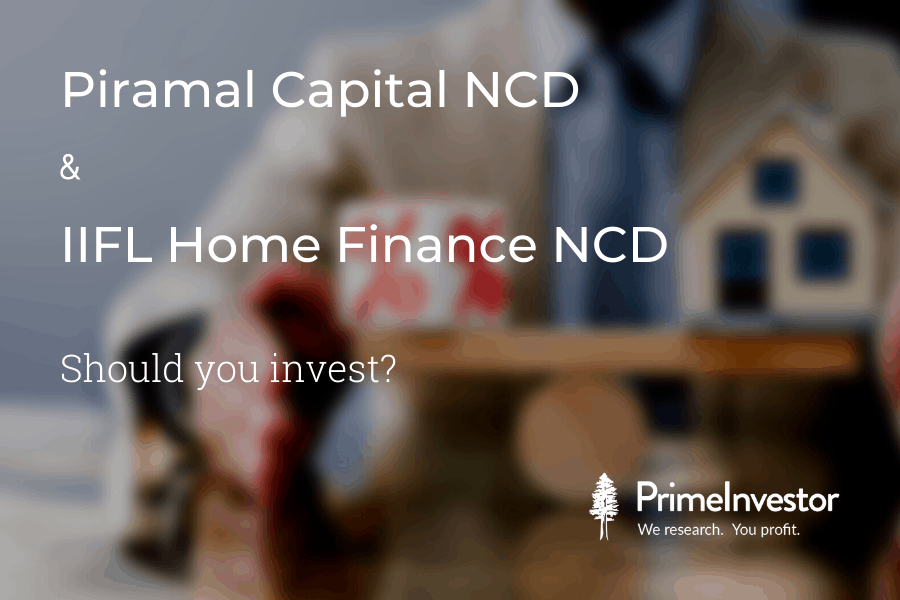Home loans are one of the safer lending avenues for NBFCs, given that they are backed by collateral that usually appreciates in price. But does that make NCD offers from two housing finance NBFCs – Piramal Capital and Housing Finance and IIFL Housing – less risky to bet on? Here’s our analysis.

Piramal Capital and Housing Finance NCDs
Piramal Capital and Housing Finance (PCHFL) is making a public issue of secured redeemable bonds to raise Rs 1000 crore (including greenshoe option). The offer is open from July 12 to July 23, but could be closed early or extended based on response. The minimum subscription is Rs 10,000 with multiples of Rs 1000 thereafter. The bonds carry a face value of Rs 1000 and will be listed and traded on both BSE and NSE. They carry no put or call option.
The bonds are secured through a pari passu charge. But given that the charge is against financial assets of the company such as receivables, investments, loans and current assets – both present and future, the value of this collateral is subjective. The company plans to use the proceeds of this bond issue for on-lending and repayment of loans.
Rates: Long-term options unattractive
PFCHL is offering five types of bonds with tenors ranging from 26 months to 120 months. Four of the options pay annual interest while one 26-month bond also has a cumulative option. The interest rates are as below:
Many analyses of this offer have noted that the interest rates of 8.35% to 9% on offer on this NCD are attractive relative to bank FDs of 1 to 3-year tenure, which offer rates of 5-6.5 per cent and PSU bonds of 5 to 10-year tenure, which offer yields of 5.8 to 6.8 per cent. But this is an apples-to-lemons comparison because PCHFL bonds carry far higher risks than either bank deposits or PSU bonds.
Given that PCHFL bonds are AA-rated (two notches below AAA), the most appropriate comparison would be with other AA rated instruments traded in the market. With bond markets preferring sovereign and AAA rated issuers in Covid times, AA rated corporate bonds are trading at spreads of over 100-150 basis points over AAA rated issuers. This is indicative of investors in them demanding higher rates to compensate for higher risks to their capital.
Comparing the yields (we have assumed coupon and yield to be the same given that coupons are paid out) on this bond offer against market yields for AA-rated bonds, it is evident that PCHFL’s 26-month and 36-month bonds with yields of 8.35% and 8.5% offer a good 200 basis points plus spread over AA-rated NBFC market yields for comparable tenures. PCHFL’s 60-month (5 year) and 120-month (10 year) bonds offer lower spreads of 110-155 points. The short term (26 and 36 month) bonds therefore offer better compensation for risks. In any case, it does not make sense for retail bond investors to take exposure to very long duration bonds of 5 or 10 year tenure today. With inflation turning out to be sticky and interest rates on the rise, prices of long-tenure bonds could take a steeper hit in the secondary market than short-term ones as yields rise.
This rules out the 5 and 10 year NCDs as investment options. If you’re considering the 26-month and 36-month bonds for investments, it is necessary to weigh the below risks against PCHFL’s business positives.
Business positives
PCHFL is an RBI-regulated housing finance company with a Rs 32,353 crore loan book as of March 31 2021. It is backed by a strong parent in Piramal Enterprises, which has an established record in the real estate industry as well as financial strength to raise both equity and debt funds in the markets at times of its choice. The parent has made regular capital infusions to strengthen PCHFL in the last couple of years.
99.7% of PCHFL’s loan book is secured, given that it lends to the real estate industry against collateral. However, as the bulk of these are developer loans perceived as quite risky by markets, the group has been attempting to diversify its loan book in the last three years and has inducted a seasoned top management team into its financial services business to aid this foray.
PCHFL’s latest financials for the year ended March 31 2021 showed a fairly strong financial profile, with profits of Rs 1034 crore (Rs 30.4 crore last year) on revenues of Rs 5081 crore (Rs 5622 crore). It had a strong net worth of Rs 11,186 crore against debt of Rs 29,867 crore. Given the moratoriums and restructuring offered to borrowers in the last two years, loan slippages could rise in future.
However, PCHFL has made proactive provisions for expected credit losses of Rs 1848 crore by March 31 2021. As of December 31 2020, the company reported gross NPAs of 2.6%, net NPAs of 1.3% and sat on comfortable Tier 1 capital of 33.03% and CRAR of 35.83% almost twice the regulatory limits. These NPA numbers however do not capture delinquencies from the restructuring packages or loan moratoriums granted during Covid. The company’s current liquidity profile is comfortable across maturities with inflows outpacing outflows.
Weighed against this though, investors in PCHFL need to factor in higher-than-normal business risks.
Business Risks
#1 Developer focus
Despite these attempts, PCHFL’s current loan book is focused more on wholesale rather than retail real estate loans. March 2021 disclosures show that retail loans accounted for 13.7% of its loan book while wholesale loans made up 77.6%. The loan book is almost entirely concentrated on the real estate sector with small exposure to renewables, logistics and autos. While retail housing loans are a relatively low-risk segment because individual home buyers, having offered their homes as collateral, rarely default on such loans, wholesale real estate loans go mainly to developers, construction companies and the real estate industry which are characterized by working capital constraints, cyclicality and high leverage.
The market aversion to such loans leads to high cost of funds for NBFCs operating in this segment. PCHFL’s move to acquire Dewan Housing Finance is also part of efforts to diversify its loan book into smaller-ticket retail housing loans which are less subject to credit risks.
An unusual risk factor for investors in this bond, is the fact that PCHFL in its current form may not even continue, once the DHFL acquisition is finalised. On obtaining all approvals, Piramal Housing plans a reverse merger of itself into the acquired DHFL, with the new entity being renamed as PCHFL. All assets and liabilities (including the current bonds) will be subsumed into the new entity.
#2 DHFL acquisition
While the DHFL acquisition may aid PCHFL’s retail foray, it does carry several imponderables. PCHFL after fiercely contested bidding, won the race to acquire the controversial Dewan Housing Finance (DHFL) at a consideration of Rs 34,250 crore to be paid through a combination of cash and NCDs.
Given that the DHFL is under investigation for allegations of funds diversion, creating fictitious loan accounts, money laundering, fraud et al, there’s considerable uncertainty about the shape of the loan book being acquired.
Paraphrasing the risk factors in the prospectus:
“We believe that there are several risks associated with the acquisition, such as more defaults than estimated coming to light, more frauds being identified which could deteriorate the value of acquisition, unexpected issues arising out of the diligence… material increase in our NPAs (on a merged basis) owing to weaker than expected quality of the portfolio being acquired, delay in integration due to delay in implementation of the Resolution Plan and litigations getting settled, reputational risk associated with DHFL, adverse outcome of any on-going litigation, among other things.”
To cut a long story short, with DHFL being the victim of fraud, its acquirer PCHFL is taking on larger risks and uncertainties than usual in using this acquisition to scale up its retail loan book.
#3 Reverse merger in the works
An unusual risk factor for investors in this bond, is the fact that PCHFL in its current form may not even continue, once the DHFL acquisition is finalised. On obtaining all approvals, Piramal Housing plans a reverse merger of itself into the acquired DHFL, with the new entity being renamed as PCHFL. All assets and liabilities (including the current bonds) will be subsumed into the new entity.
Whether credit rating agencies, given DHFL’s chequered record will be willing to retain PCHFL’s current credit ratings after this event needs to be seen. If there are downgrades, that will have an adverse impact on the traded price of these bonds, while also affecting PCHFL’s ability to source funds for lending at current interest rates.
Perhaps owing to the exposure to the real estate sector and these uncertainties, the credit ratings of PCHFL NCDs have been qualified by rating agencies. They have been rated CARE AA (Under credit watch with developing implications) and ICRA AA (Negative outlook).
Overall, the higher yields on PCHFL bonds come with higher-than-usual risks to your investment. Fixed income investors who prioritise capital protection can therefore skip this public issue.
IIFL Home Finance NCDs
IIFL Home Finance from the India Infoline group, is making a public issue of NCDs to raise Rs 5,000 crore. The offer opened on July 6 and closes on July 28 2021. It may close early based on response. The bonds carry a Rs 1000 face value and will list and trade on both exchanges. The proceeds will be used to repay loans and for on-lending.
Security
Unlike the PCHFL bonds, these bonds are unsecured and subordinated. This means that should the company default, claims of other creditors will rank above the holders of the current NCDs. This makes the bonds riskier than other secured NCD issues.
Ratings
The bonds are rated AA (Stable) by CRISIL and AA+ (Negative) by Brickworks.
Business
IIFL Home Finance is mainly into retail housing loans, with 96% of its loans outstanding in retail mortgages, making for a fairly low risk loan book. It has just 4% outstanding in wholesale loans. Being a retail lender, the company has low concentration risks. One fourth of its loans have a loan-to-value of 80-90% (high LTV makes the collateral value vulnerable to housing price fluctuations) and another 24% has LTV of 70-80%. The rest of the book has a higher margin of safety on LTVs.
Its loans are mainly focussed on the Delhi NCR (28.4% of loans), Mumbai (16.2%) and Gujarat (9.76%) markets. On a Rs 20,693 crore loan book as of March 31 2021, the company reported Gross NPAs of Rs 352.7 crore and net NPAs of Rs 169.2 crore as of March 31 2021. The NPAs on retail loans, the largest segment stood at a modest 1.5%.
Rates
IIFL Home Finance is offering three types of NCDs all with a 87 month tenure (7.25 years). The mode of payout and returns differ slightly on the three options. In the annual payout option, the annual coupon rate is 10%, the monthly payout option offers interest of 9.6% (this translates into a yield of 10.03% if the interest is reinvested) and the cumulative option offers to double your money at maturity after 87 months, translating into an effective yield of 10.02%. The IIFL bonds do offer better compensation for risks to your capital than PCHFL bonds.
However, the bonds’ long tenure of 87 months makes them quite vulnerable to interest rate risks. Today, not only is the MPC holding policy rates at record low levels due to growth concerns arising from Covid, RBI is also artificially holding market yields low through its direct interventions. Neither state of affairs may last beyond this fiscal, as growth picks up or inflation concerns persist. Should interest rates rise sharply from here, long-term bonds like IIFL’s could trade at discounts to face value in the secondary market for investors who seek to sell them before maturity.
Investing in short term or floating rate bonds is more advisable given the current rate outlook.






8 thoughts on “2 bond offers playing on home loans – should you invest?”
Thanks for the detailed views as always. Few queries if can have your view on below 2 key risks as mentioned :
1. Skewed developer book: Wont this risk get mitigated considering the profile of quality of developers where piramal has exposure to + over next 2 years real estate is expected to be on up swing further helping the major developers. Will this help mitigate this risk ?
2. Dewan acquisition risk : Dewan housing book has been discounted by 65 % + haircut, wont this mitigate this risk of quality of loans ?
Appreciate your views. Thanks..
The first risk of developer loans can get mitigated with an upturn in the real estate cycle. But on DHFL the prime portion of the loan book was already sold/securitised in rescue efforts before the company went to IBC. Plus investigations are on for fraud, money laundering etc. Therefore I think risks could lurk there.
Very well researched analysis on both NCD issues – just one clarification required- basis your analysis of Piramal NCDs, can we invest minimum amount in range of Rs 10,000 to Rs 12,000 for 26 months in above issue?
Yes the returns are attractive but you should be willing to risk losing this sum. The next 1 to 2 years is when the DHFL merger will happen.
Thanks a lot Madam for explaining the plus and minus factors of both issues.
Sudhakarudu
Aarati – any views on the existing leverage of both the companies? and how would it compare it to other healthy NBFCs/HFCs?
Leverage levels are quite low for both compared to peers. But for Piramal there could be upside to leverage once DHFL loan book comes into play.
Simple and great as always aarati mem.
Comments are closed.